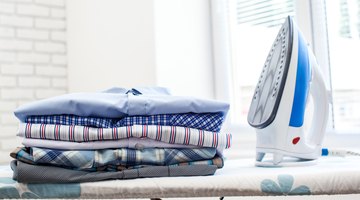Ironing Board Functions
Using an ironing board and iron is still the most popular and easiest way to keep clothes wrinkle-free. The function of an ironing board has not changed much since its introduction to the public, but different portability and storage designs have made using a board convenient for nearly everyone.

Ironing board design hasn't changed much since the late 19th century. Although the primary purpose of an ironing board is to keep clothes wrinkle-free, it also has multiple uses, which comes in handy in smaller living spaces.
Using an ironing board and a hot iron is still the most common way to press clothes. An ironing board may be built into kitchen cabinetry or it may be a stand-alone item, but its design and function are still very much the same.
How Ironing Board Design Lends Itself to Wrinkle-free Clothes
An ironing board is padded and covered to withstand the heat of an iron. Although some people like to use a towel on a flat surface to mimic a board's function, it is easier to keep clothes wrinkle-free using an actual ironing board, as it is slimmer on one end. A sleeve or pant leg is wrapped around the thin end of the board to better press an iron into curved areas of a garment and move it with ease.
A built-in ironing board does not have the option of height adjustment but still works much in the same way a stand-alone board does. Wall built-in boards stand on end, hidden in cabinetry when they are not in use, but fold down for ironing. A compact table board is also not height adjustable, but it often has collapsible legs for storage purposes.
Ironing Using an Ironing Board
If the ironing board is a full-size, stand-alone model, it will have collapsible legs that cross underneath. When its legs are folded, the board stands on its end for easy storage in small spaces. To unfold the board, hold it upright and adjust by merely moving the legs to the desired height with the lever under the board, and "click" into place. The board should be about waist-high for comfortable use. To close the board after ironing, stand it on its end and move the lever underneath to collapse the legs.
To use a wall built-in board, just open the cabinetry and pull the board down. For a compact table board, stand the board on a flat surface to iron.
Other Ironing Board Uses
With the advent of tumble dryers, ironing isn't as necessary or popular as it was in days past. Sometimes, an old ironing board can double as a shelf, a tabletop or even an organizational tool in smaller spaces.
To repurpose an ironing board as a shelf or table, decorate it by painting or covering it to match the decor. Ironing boards are sturdy by design and can easily handle the weight of a laptop, books or other shelving accouterments.
To use the board as an organizational tool, separate its top from its legs. Remove the padding and cover to reveal the metal base of the board top. Mount the board top to a wall, and add hooks to the already existing holes in the board to hold everything from jewelry to tools neatly.
References
Writer Bio
Michelle Nati worked in the entertainment industry for several years before before becoming a purveyor of oddities for Oddee.com. She has also written for Pasadena Now, The Farmers’ Almanac, ApartmentShowcase, Complex Media, Time Out, Ranker, Mstarz, and a host of other websites as a news, web content and feature writer. She lives in Los Angeles with her dog, Benny.
More Articles



